Shockwave Therapy (ESWT) Singapore
Shockwave therapy (ESWT) is a non-invasive treatment used for chronic pain and tendon injuries. Dr Foo applies focused shockwave energy to stimulate healing, reduce inflammation, and support tissue repair for lasting relief.
MBBS (University of London) | MMed (Ortho) | FRCSEd (Ortho) | FAMS (Ortho)


What Is Shockwave Therapy (ESWT)?
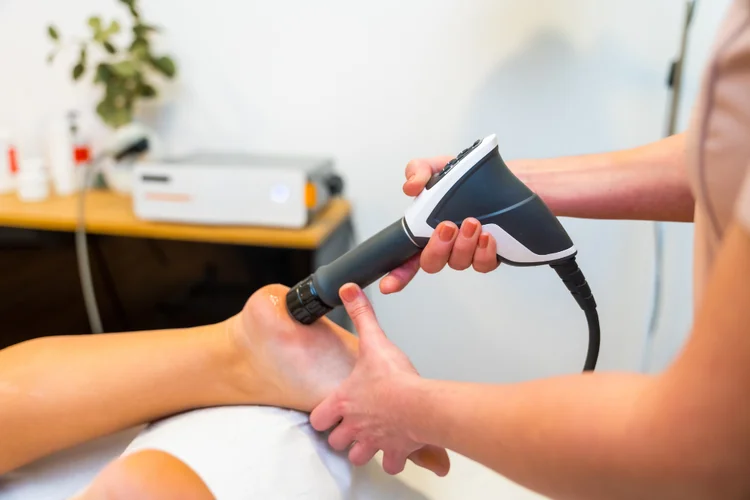
Shockwave therapy (Extracorporeal Shockwave Therapy or ESWT) is a non-invasive treatment
that uses acoustic waves to stimulate the body’s natural healing processes in
musculoskeletal conditions.
It can enhance blood circulation, promotes tissue regeneration, and helps reduce chronic
pain by transmitting mechanical energy through the skin into targeted tissues. It is often
considered as a supportive option when other non-surgical treatments such
as rest, manual therapy, or medication have not provided adequate relief.
At Apex Sports Clinic, we begin every case with a thorough diagnosis to
better understand the underlying cause of your pain or injury. A clear clinical assessment
helps determine whether shockwave therapy is suitable and how it should be applied to
support your recovery.
We offer shockwave therapy for a range of orthopaedic and sports-related issues, with
sessions starting from $100.
How Does Shockwave Therapy Work?
Shockwave therapy works by sending high-energy sound waves
into the affected area, creating small vibrations in the tissues that
stimulate blood flow and activate the body’s natural healing response.
This process can help break down calcium deposits, which are hardened buildups that
may form in soft tissues following injury or inflammation, reduce chronic swelling,
and support healthy cell function and tissue repair.
The treatment is particularly useful for injuries involving tendons, ligaments, or connective
tissues such as those in the shoulder, elbow, knee, heel, or foot, especially when rest,
physiotherapy, or medication have not fully resolved the issue.
What Conditions Can Shockwave Therapy Help Treat?
Shockwave therapy is commonly used for a range of orthopaedic and sports-related conditions that involve chronic inflammation or soft tissue damage. These often result in persistent pain linked to delayed or incomplete tissue healing.
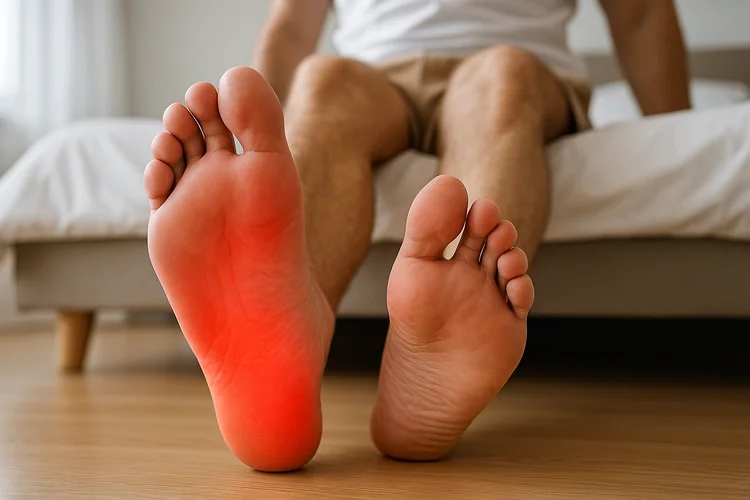
Common conditions treated with shockwave therapy include:
- Plantar fasciitis and heel spurs
- Achilles tendinopathy
- Patellar tendinopathy (jumper’s knee)
- Tennis elbow (lateral epicondylitis)
- Calcific tendinitis of the shoulder
- Rotator cuff tendinopathy
- Greater trochanteric pain syndrome
- Golfer’s elbow (medial epicondylitis)
- Myofascial trigger points
- Shin splints
What Are the Benefits of Shockwave Therapy?
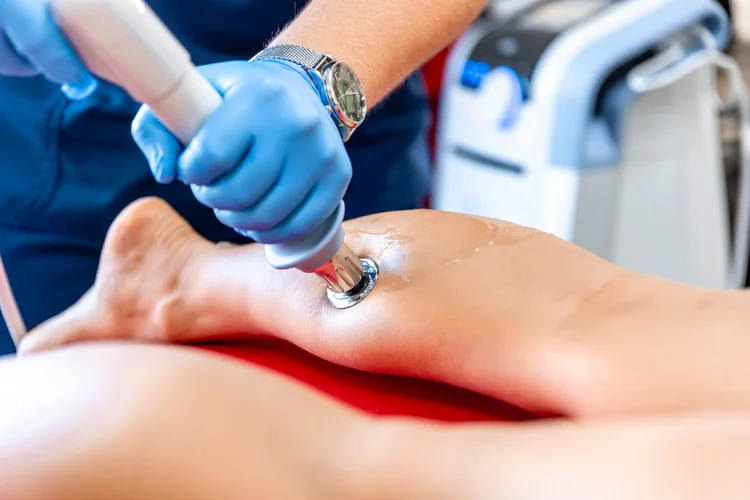
Shockwave therapy is widely regarded as a viable non-invasive option for promoting healing
in chronic soft tissue injuries.
Key benefits may include:
- Reduction in chronic pain
- Improved mobility and function
- Stimulation of natural tissue repair
- Often no need for anaesthesia or medication
- Minimal recovery time required
Patients typically notice gradual improvement after a few sessions, depending on the condition and its severity.
Shockwave Therapy at Apex Sports Clinic

1. Proper Diagnosis
Our specialists are medically trained to assess your condition thoroughly. We focus on identifying the root cause before recommending any treatment.
2. Determining Suitability
Shockwave therapy is only advised when there's a strong chance it will benefit your condition. This ensures you receive appropriate and effective care.
3. Specialist-Led Shockwave Therapy
If suitable, treatment is performed by experienced professionals who monitor your progress closely. We make adjustments along the way to support your recovery.
What Happens During a Shockwave Therapy Session?
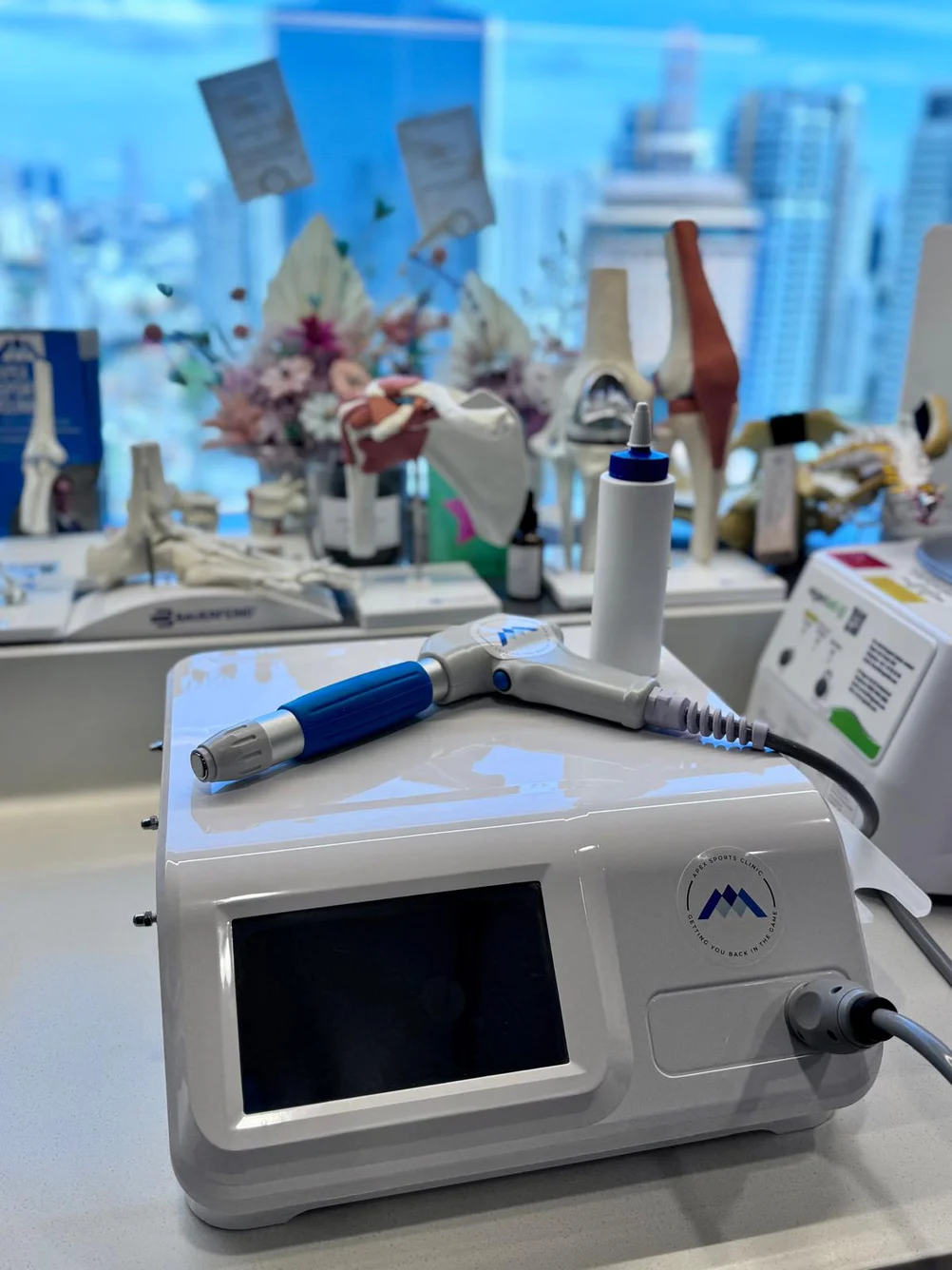
During a shockwave therapy session, conductive gel is applied to the treatment area, and the
shockwave device is placed against the skin to deliver acoustic waves into the underlying
tissue.
You may feel a mild tapping sensation or some discomfort, depending on the intensity used
and your individual sensitivity.
Each session typically lasts 15 to 20 minutes. Most treatment plans
involve 1 session per week for 3 to 6 weeks, although this may vary based
on your condition and response to therapy.
Is Shockwave Therapy Suitable for Everyone?
Shockwave therapy is not suitable for everyone and is generally not recommended for individuals with:
- Blood clotting disorders
- Use of anticoagulant medication
- Active infections or open wounds at the treatment site
- Pregnancy
- Presence of tumours in the treatment area
- Use of pacemakers or implanted electronic devices near the site
If you're unsure, speak with our friendly orthopaedic specialists at Apex to find out more today.
Are There Any Side Effects or Downtime?
Side effects of shockwave therapy are generally mild and temporary. Some patients may experience:
- Localised redness or swelling
- Mild bruising
- Discomfort during or after treatment
These effects usually resolve within a few days. Most people can return to their usual daily activities immediately, although high-impact sports or intensive physical activity may need to be postponed based on your condition and the instructions provided by your specialist.
How Much Does Shockwave Therapy Cost in Singapore?
At Apex Sports Clinic, we offer shockwave therapy alongside related services for musculoskeletal and sports-related conditions at the following rates:
| Treatment | Price |
|---|---|
| Initial Consultation | From $200 |
| Shockwave Therapy | From $100 per session |
| Diagnostic Imaging if required (performed by external provider) | |
| X-ray | From $100 |
| Ultrasound | From $100 |
| MRI Scan | From $1000 |
| Other Non-Invasive Treatments | |
| Physiotherapy | From $150 per session |
| Sports Physiotherapy | From $200 per session |
| Gait Analysis | From $200 per session |
For a detailed overview of our orthopaedic service and treatment fees, please refer to our price list.
Is Shockwave Therapy Covered by Insurance?
While shockwave therapy is not always covered by insurance, some health insurance providers may partially reimburse sessions when medically indicated. It is advisable to check with your insurer in advance.
Every patient deserves a treatment plan tailored to their needs. We start with non-surgical approaches before considering more invasive interventions.
Where Can I Receive Shockwave Therapy in Singapore?
Apex Novena
admin@apexsportsclinic.sg
101 Irrawaddy Rd, #18-12 Royal Square Medical Centre, Singapore 329565
Nearest MRT: NS20 Novena
Apex East Coast
admin@apexsportsclinic.sg
112 E Coast Rd, #03-03/04 i12 Katong, Singapore 428802
Nearest MRT: TE26 Marine Parade
Why Do Patients Choose Apex Sports Clinic?
Sports Doctor in Singapore: Personalised & Affordable Care
Progressive Treatment Philosophy
We prioritise personalised, non-invasive solutions, progressing to specialised treatments, including surgery, only when needed for more effective and targeted care.
Holistic Patient-Centred Care
From diagnosis to rehabilitation, we provide comprehensive and seamless care for a wide range of orthopaedic conditions.
Specialist in Sports Orthopaedics & Injury Management
We combine expert injury management with a proactive approach to maintaining your body’s strength and function, so you can recover fully and perform at your peak.
Patient Journey
1 . Schedule Your Appointment

2 . Expert Diagnosis & Consultation

3 . Customised Treatment Plan

Schedule an Appointment

Our Insurance Partners






Frequently Asked Questions (FAQs)
Shockwave therapy in Chinese is commonly referred to as “体外冲击波治疗” (tǐwài chōngjībō zhìliáo). This term describes the non-invasive application of focused or radial acoustic energy from outside the body to promote healing of musculoskeletal conditions. It is widely used for chronic tendon injuries, ligament pain, and other soft tissue disorders.
Shockwave therapy may cause mild to moderate discomfort during treatment, but this usually depends on the energy level used and individual pain sensitivity. Most patients describe it as a tapping or pulsing sensation that is tolerable and temporary. Discomfort typically subsides shortly after each session.
Focused shockwave therapy delivers energy more deeply and precisely into targeted tissues, while radial shockwave therapy disperses energy over a broader, shallower area. The choice depends on the condition being treated, with focused therapy often used for deeper injuries and radial therapy for more superficial or widespread pain.
At Apex Sports Clinic, shockwave therapy sessions start from $100, with final costs depending on your condition and the number of sessions needed. This fee excludes initial consultation and any diagnostic imaging that may be recommended to support your treatment plan.
Shockwave therapy is widely considered a supportive option for treating chronic musculoskeletal conditions when other non-surgical treatments have not been effective. While outcomes vary by condition and individual, many patients experience gradual pain reduction and functional improvement. It is best to consult your orthopaedic specialist who can help determine its suitability based on your condition and needs.
Most patients undergo 3 to 6 shockwave therapy sessions, spaced about one week apart, although the exact number may vary depending on the condition’s severity and individual response. It is advisable to consult your physiotherapist or orthopaedic doctor to help tailor an appropriate treatment plan for your needs.
Shockwave therapy may cause temporary discomfort, redness, bruising, or swelling in the treated area, especially in the initial sessions. These effects are usually mild and resolve within a few days. Some patients may also find the tapping sensation uncomfortable. While widely regarded as a supportive treatment, shockwave therapy may not be effective for all individuals or conditions. It is advisable to consult your orthopaedic surgeon to determine if this therapy is appropriate for your needs.
The therapeutic effects of shockwave therapy are typically cumulative and may last for several months, especially in chronic conditions. Most patients notice gradual improvement over 3 to 6 sessions, with benefits continuing to develop over time as tissue healing progresses. The longevity of results varies depending on the condition being treated, its severity, and individual response. It is advisable to consult your orthopaedic specialist to assess treatment progress and expected outcomes.
After shockwave therapy, you should avoid high-impact or strenuous activities involving the treated area for at least 48 hours, unless advised otherwise by your specialist. Applying ice or anti-inflammatory medication is generally discouraged immediately after treatment, as it may interfere with the body’s natural healing response. Following your specialist’s post-treatment instructions is important to support optimal recovery and treatment outcomes.
Shockwave therapy has demonstrated favourable outcomes for various musculoskeletal conditions, with higher success rates seen in plantar fasciitis and calcific tendinopathy. Results vary depending on the condition treated, treatment protocol, and individual response. Most patients report noticeable clinical improvement after multiple sessions. It is advisable to consult your orthopaedic specialist to determine if shockwave therapy is appropriate for your condition and to discuss likely treatment outcomes.
Shockwave therapy is commonly administered once weekly over 3 to 6 sessions, although the number of sessions may vary based on your condition and response. In some cases, additional sessions may be recommended or spaced further apart. Repeat treatments can be considered if symptoms persist or recur. Consulting your orthopaedic specialist can help determine the most appropriate treatment frequency and duration for your situation.

